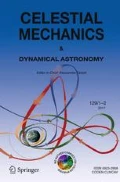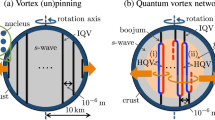Abstract
We revisit the problem of secular resonance sweeping during the dissipation of a protoplanetary disk and its possible role in exciting the orbits of primordial asteroids, in light of recent models of Solar system evolution. We develop an integrator that incorporates the gravitational effect of a uniformly (or not) depleting, axisymmetric disk with arbitrary surface density profile; its performance is verified by analytical calculations. The secular response of fictitious asteroids, under perturbations from Jupiter, Saturn and a decaying disk, is thoroughly studied. Note that the existence of a symmetry plane induced by the disk lifts the inherent degeneracy of the two-planet system, such that the ‘\(s_5\)’ nodal frequency can also play a major role. We examine different resonant configurations for the planets (2:1, 3:2, 5:3), disk models and depletion scenarios. For every case, we compute the corresponding time paths of secular resonances, which show when and where resonance crossing occurs. The excitation of asteroids, particularly in inclination, is studied in the various models and compared to analytical estimates. We find that inclination excitation in excess of \(\sim 10^{\circ }\) is possible in the asteroid belt, but the nearly uniform spread of \(\Delta i\sim 20^{\circ }\) observed calls for the combined action of secular resonance sweeping with other mechanisms (e.g., scattering by Mars-sized embryos) that would be operating during terrestrial planet formation. Our results are also applicable to extrasolar planetary systems.
















Similar content being viewed by others
Notes
We used the code developed by D. \(\text {Nesvorn}\grave{y}\) that can be found at https://www.boulder.swri.edu/~davidn/fmft/fmft.html.
References
Adams, F.C.: The Birth environment of the solar system. Annu. Rev. Astron. Astrophys. 48, 47–85 (2010)
Alexander, R.D., Clarke, C.J., Pringle, J.E.: Photoevaporation of protoplanetary discs-I. Hydrodynamic models. Mon. Not. R. Astron. Soc. 369, 216–228 (2006a)
Alexander, R.D., Clarke, C.J., Pringle, J.E.: Photoevaporation of protoplanetary discs-II. Evolutionary models and observable properties. Mon. Not. R. Astron. Soc. 369, 229–239 (2006b)
Alexander, R., Pascucci, I., Andrews, S., Armitage, P., Cieza, L.: The dispersal of protoplanetary disks. In: Protostars and Planets VI, pp. 475–496. University of Arizona Press, Tucson (2014)
Andrews, S.M., Wilner, D.J., Hughes, A.M., Qi, C., Dullemond, C.P.: Protoplanetary disk structures in Ophiuchus. II. Extension to fainter sources. Astrophys. J. 723, 1241–1254 (2010)
Baguet, D., Morbidelli, A., Petit, J.-M.: Positions of the secular resonances in the primordial Kuiper Belt disk. Icarus (in Press) (2019)
Chambers, J.E.: A hybrid symplectic integrator that permits close encounters between massive bodies. Mon. Not. R. Astron. Soc. 304, 793–799 (1999)
Clarke, C.J., Gendrin, A., Sotomayor, M.: The dispersal of circumstellar discs: the role of the ultraviolet switch. Mon. Not. R. Astron. Soc. 328, 485–491 (2001)
Crida, A.: Minimum mass solar nebulae and planetary migration. Astrophys. J. 698, 606–614 (2009)
Deienno, R., Izidoro, A., Morbidelli, A., Gomes, R.S., Nesvorný, D., Raymond, S.N.: Excitation of a primordial cold asteroid belt as an outcome of planetary instability. Astrophys. J. 864, 50 (2018)
Duncan, M.J., Levison, H.F., Lee, M.H.: A multiple time step symplectic algorithm for integrating close encounters. The Astron. J. 116, 2067–2077 (1998)
Goldreich, P., Tremaine, S.: Disk-satellite interactions. Astrophys. J. 241, 425–441 (1980)
Gomes, R., Levison, H.F., Tsiganis, K., Morbidelli, A.: Origin of the cataclysmic late heavy bombardment period of the terrestrial planets. Nature 435, 466–469 (2005)
Hartmann, L., Calvet, N., Gullbring, E., D’Alessio, P.: Accretion and the evolution of T Tauri disks. Astrophys. J. 495, 385–400 (1998)
Hayashi, C.: Structure of the solar nebula, growth and decay of magnetic fields and effects of magnetic and turbulent viscosities on the nebula. Prog. Theor. Phys. Suppl. 70, 35–53 (1981)
Heppenheimer, T.A.: Secular resonances and the origin of eccentricities of Mars and the asteroids. Icarus 41, 76–88 (1980)
Huré, J.-M.: A key-formula to compute the gravitational potential of inhomogeneous discs in cylindrical coordinates. Celest. Mech. Dyn. Astron. 114, 365–385 (2012)
Huré, J.-M., Trova, A., Hersant, F.: Self-gravity in curved mesh elements. Celest. Mech. Dyn. Astron. 118, 299–314 (2014)
Izidoro, A., Raymond, S.N., Pierens, A., Morbidelli, A., Winter, O.C., Nesvorný, D.: The asteroid belt as a relic from a chaotic early solar system. Astrophys. J. 833, 40 (2016)
Kuzmin, G.G.: Ehffekt sblizhenij zvezd i ehvolyuciya zvezdnyh skoplenij. The effect of star encounters and the evolution of star clusters. Publ. Tartu Astrofiz. Obs. 33, 75–102 (1957)
Lecar, M., Franklin, F.: The solar nebula, secular resonances, gas drag, and the asteroid belt. Icarus 129, 134–146 (1997)
Lemaitre, A., Dubru, P.: Secular resonances in the primitive solar nebula. Celest. Mech. Dyn. Astron. 52, 57–78 (1991)
Levison, H.F., Morbidelli, A., Tsiganis, K., Nesvorný, D., Gomes, R.: Late orbital instabilities in the outer planets induced by interaction with a self-gravitating planetesimal disk. Astron. J. 142, 152 (2011)
Lin, D.N.C., Papaloizou, J.: Tidal torques on accretion discs in binary systems with extreme mass ratios. Mon. Not. R. Astron. Soc. 186, 799–812 (1979)
Lynden-Bell, D., Pringle, J.E.: The evolution of viscous discs and the origin of the nebular variables. Mon. Not. R. Astron. Soc. 168, 603–637 (1974)
Minton, D.A., Malhotra, R.: Secular resonance sweeping of the main asteroid belt during planet migration. Astrophys. J. 732, 53 (2011)
Miyamoto, M., Nagai, R.: Three-dimensional models for the distribution of mass in galaxies. Publ. Astron. Soc. Jpn. 27, 533–543 (1975)
Morbidelli, A., Levison, H.F., Tsiganis, K., Gomes, R.: Chaotic capture of Jupiter’s Trojan asteroids in the early solar system. Nature 435, 462–465 (2005)
Morbidelli, A., Tsiganis, K., Crida, A., Levison, H.F., Gomes, R.: Dynamics of the giant planets of the solar system in the gaseous protoplanetary disk and their relationship to the current orbital architecture. Astron. J. 134, 1790–1798 (2007)
Morbidelli, A., Lambrechts, M., Jacobson, S., Bitsch, B.: The great dichotomy of the solar system: small terrestrial embryos and massive giant planet cores. Icarus 258, 418–429 (2015)
Nagasawa, M., Tanaka, H., Ida, S.: Orbital evolution of asteroids during depletion of the solar nebula. Astron. J. 119, 1480–1497 (2000)
Nagasawa, M., Ida, S., Tanaka, H.: Origin of high orbital eccentricity and inclination of asteroids. Earth Planets Space 53, 1085–1091 (2001)
Nagasawa, M., Ida, S., Tanaka, H.: Excitation of orbital inclinations of asteroids during depletion of a protoplanetary disk: dependence on the disk configuration. Icarus 159, 322–327 (2002)
O’Brien, D.P., Morbidelli, A., Bottke, W.F.: The primordial excitation and clearing of the asteroid belt–revisited. Icarus 191, 434–452 (2007)
Owen, J.E., Ercolano, B., Clarke, C.J., Alexander, R.D.: Radiation-hydrodynamic models of X-ray and EUV photoevaporating protoplanetary discs. Mon. Not. R. Astron. Soc. 401, 1415–1428 (2010)
Owen, J.E., Ercolano, B., Clarke, C.J.: Protoplanetary disc evolution and dispersal: the implications of X-ray photoevaporation. Mon. Not. R. Astron. Soc. 412, 13–25 (2011)
Plummer, H.C.: On the problem of distribution in globular star clusters. Mon. Not. R. Astron. Soc. 71, 460–470 (1911)
Schulz, E.: The gravitational force and potential of the finite mestel disk. Astrophys. J. 747, 106 (2012)
Tsiganis, K., Gomes, R., Morbidelli, A., Levison, H.F.: Origin of the orbital architecture of the giant planets of the Solar System. Nature 435, 459–461 (2005)
Walsh, K.J., Morbidelli, A., Raymond, S.N., O’Brien, D.P., Mandell, A.M.: A low mass for Mars from Jupiter’s early gas-driven migration. Nature 475, 206–209 (2011)
Ward, W.R.: Solar nebula dispersal and the stability of the planetary system I. Scanning secular resonance theory. Icarus 47, 234–264 (1981)
Weidenschilling, S.J.: Aerodynamics of solid bodies in the solar nebula. Mon. Not. R. Astron. Soc. 180, 57–70 (1977)
Author information
Authors and Affiliations
Corresponding author
Ethics declarations
Conflict of interest
The authors declare that they have no conflict of interest.
Additional information
Publisher's Note
Springer Nature remains neutral with regard to jurisdictional claims in published maps and institutional affiliations.
Rights and permissions
About this article
Cite this article
Toliou, A., Tsiganis, K. & Tsirvoulis, G. Secular resonance sweeping and orbital excitation in decaying disks. Celest Mech Dyn Astr 132, 1 (2020). https://doi.org/10.1007/s10569-019-9942-0
Received:
Revised:
Accepted:
Published:
DOI: https://doi.org/10.1007/s10569-019-9942-0



